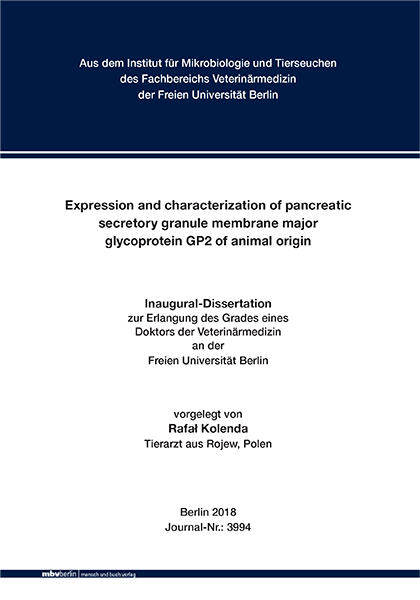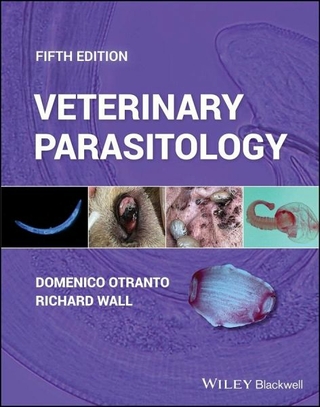
Expression and characterization of pancreatic secretory granule membrane major glycoprotein GP2 of animal origin
Seiten
2018
|
1. Aufl.
Mensch & Buch (Verlag)
978-3-86387-878-8 (ISBN)
Mensch & Buch (Verlag)
978-3-86387-878-8 (ISBN)
- Keine Verlagsinformationen
- Artikel merken
GP2 is specifically expressed on the surface of M cells and takes part in the uptake of type 1 fimbriae (T1F)-positive bacteria and transport to underlying mucosal immune tissues. This process continues with the local and systemic dissemination of bacteria. T1F are one of the most common adhesive organelles in the family of Enterobacteriaceae and important adhesion factors in Salmonella intestinal pathogenicity. The FimH protein is located on top of the T1F shaft and directly interacts with receptors. Several studies have shown that serovar-associated FimH variants can differ significantly in receptor recognition and this can lead to a change in course of infection. Therefore, the aim of this study was to investigate the role of FimH sequence variation on binding to GP2 isoforms from various hosts. Porcine GP2 isoforms were expressed in SF9 cells. FimH gene sequences from 128 Salmonella isolates from five serovars of human, cattle, swine and chicken origin were determined. Expression of FimH protein in these isolates was tested with a static anti-FimH antibody adhesion assay. An isogenic system with one Salmonella strain was generated. A fimH deletion mutant was created and ten plasmids containing fimH variants were transformed into this mutant. Static adhesion assays with four human and two porcine GP2 isoforms, HRP, RNase B and anti-FimH antibody were performed. HEp-2 and IPEC-J2 cells expressing human and porcine GP2 isoforms were generated with the use of lentiviral expression system. Next, infection assays with these cell lines and an isogenic Salmonella model were carried out. Comparison of fimH gene sequences from Salmonella isolates revealed 11 sequence variants with 18 variable sites. T1F expression was dependent on serovar and isolation source. Cluster analysis revealed, that T1F expression is higher in strains from host-unrestricted compared to host-associated or host-restricted serovars. In the isogenic Salmonella model, binding to GP2 isoforms and standard proteins was FimH-variant and mannose-dependent, and glucose independent. The high binding phenotype was observed in the case of four FimH variants, low in case of three variants and no binding in case of three variants. In cell line infection assays, GP2-cell line expression dependent binding was observed in the case of three FimH variants with high binding phenotype. No host-specific binding of FimH adhesins to GP2 was observed in static adhesion assays and cell line infection assays. Adhesion of FimH-positive bacteria to GP2 might be an additional entry route for Salmonella invasion. Expression und Charakterisierung von pankreatischen sekretorischen Granulamembran Glykoprotein GP2 von tierischen Ursprung
GP2 wird spezifisch auf der Oberfläche von M-Zellen exprimiert und ist an der Aufnahme von Typ-1-Fimbrien (T1F) -positiven Bakterien und dem Transport zu dem darunter liegenden Mukosagewebe beteiligt. Diesem Prozess folgt die lokale und systemische Verbreitung von Bakterien. T1F zählen zu den häufigsten adhäsiven Organellen in der Familie der Enterobacteriaceae und sind wichtige Adhäsionsfaktoren in der intestinalen Pathogenität von Salmonella. Das FimH-Protein befindet sich an der Spitze des T1F-Schafts und interagiert direkt mit Rezeptoren. Mehrere Studien haben gezeigt, dass sich Serotyp-assoziierte FimH-Varianten bei der Rezeptorerkennung erheblich unterscheiden können und dies zu einer Veränderung im Verlauf der Infektion führen kann. Daher war das Ziel dieser Studie, die Rolle der FimH-Sequenzvariation bei der Bindung an GP2-Isoformen von verschiedenen Wirten zu untersuchen. Porcine GP2-Isoformen wurden in SF9-Zellen exprimiert. FimH-Gensequenzen aus 128 Salmonella-Isolaten von fünf Serovaren von Mensch, Rind, Schwein und Huhn wurden bestimmt. Die Expression des FimH-Proteins in diesen Isolaten wurde mit einem statischen Anti-FimH-Antikörper-Adhäsionstest geprüft. Es wurde ein isogenes System mit einem Salmonella-Stamm generiert. Eine fimH-Deletionsmutante wurde erzeugt und zehn Plasmide, die fimH-Varianten enthielten, wurden in diese Mutante transformiert. Statische Adhäsionsassays mit vier humanen und zwei porcinen GP2-Isoformen, HRP, RNase B und Anti-FimH-Antikörper wurden durchgeführt. HEp-2- und IPEC-J2-Zellen, die humane und porcine GP2-Isoformen exprimieren, wurden unter Verwendung eines lentiviralen Expressionssystems erzeugt. Als nächstes wurden Infektionsassays mit diesen Zelllinien und dem isogenen Salmonella-Modell durchgeführt. Der Vergleich von fimH-Gensequenzen aus Salmonella-Isolaten ergab 11 Sequenzvarianten mit 18 variablen Stellen. Die T1F-Expression war abhängig vom Serotyp und der Isolationsquelle. Eine Cluster-Analyse ergab, dass die T1FExpression in Stämmen von Nicht-Wirts-beschränkten im Vergleich zu Wirts-assoziierten oder Wirts-beschränkten Serovaren höher ist. Im isogenen Salmonella-Modell war die Bindung an GP2-Isoformen und an Standardproteine FimH-Varianten- und mannoseabhängig und glukoseunabhängig. Ein stark bindender Phänotyp wurde bei vier FimH-Varianten beobachtet, ein niedrig bindender bei drei Varianten und keine Bindung bei den anderen drei Varianten. In Zelllinien-Infektionsassays wurde eine Bindung abhängig von der GP2-Expression der Zelllinie im Fall von drei FimH-Varianten des stark bindenden Phänotyps beobachtet. Es wurde keine wirtsspezifische Bindung des FimH-Adhäsins an GP2 in statischen Adhäsionsassays und Zelllinien-Infektionsassays beobachtet. Die Adhäsion von FimH-positiven Bakterien an GP2 könnte ein zusätzlicher Eintrittsweg für die Invasion von Salmonella sein.
GP2 wird spezifisch auf der Oberfläche von M-Zellen exprimiert und ist an der Aufnahme von Typ-1-Fimbrien (T1F) -positiven Bakterien und dem Transport zu dem darunter liegenden Mukosagewebe beteiligt. Diesem Prozess folgt die lokale und systemische Verbreitung von Bakterien. T1F zählen zu den häufigsten adhäsiven Organellen in der Familie der Enterobacteriaceae und sind wichtige Adhäsionsfaktoren in der intestinalen Pathogenität von Salmonella. Das FimH-Protein befindet sich an der Spitze des T1F-Schafts und interagiert direkt mit Rezeptoren. Mehrere Studien haben gezeigt, dass sich Serotyp-assoziierte FimH-Varianten bei der Rezeptorerkennung erheblich unterscheiden können und dies zu einer Veränderung im Verlauf der Infektion führen kann. Daher war das Ziel dieser Studie, die Rolle der FimH-Sequenzvariation bei der Bindung an GP2-Isoformen von verschiedenen Wirten zu untersuchen. Porcine GP2-Isoformen wurden in SF9-Zellen exprimiert. FimH-Gensequenzen aus 128 Salmonella-Isolaten von fünf Serovaren von Mensch, Rind, Schwein und Huhn wurden bestimmt. Die Expression des FimH-Proteins in diesen Isolaten wurde mit einem statischen Anti-FimH-Antikörper-Adhäsionstest geprüft. Es wurde ein isogenes System mit einem Salmonella-Stamm generiert. Eine fimH-Deletionsmutante wurde erzeugt und zehn Plasmide, die fimH-Varianten enthielten, wurden in diese Mutante transformiert. Statische Adhäsionsassays mit vier humanen und zwei porcinen GP2-Isoformen, HRP, RNase B und Anti-FimH-Antikörper wurden durchgeführt. HEp-2- und IPEC-J2-Zellen, die humane und porcine GP2-Isoformen exprimieren, wurden unter Verwendung eines lentiviralen Expressionssystems erzeugt. Als nächstes wurden Infektionsassays mit diesen Zelllinien und dem isogenen Salmonella-Modell durchgeführt. Der Vergleich von fimH-Gensequenzen aus Salmonella-Isolaten ergab 11 Sequenzvarianten mit 18 variablen Stellen. Die T1F-Expression war abhängig vom Serotyp und der Isolationsquelle. Eine Cluster-Analyse ergab, dass die T1FExpression in Stämmen von Nicht-Wirts-beschränkten im Vergleich zu Wirts-assoziierten oder Wirts-beschränkten Serovaren höher ist. Im isogenen Salmonella-Modell war die Bindung an GP2-Isoformen und an Standardproteine FimH-Varianten- und mannoseabhängig und glukoseunabhängig. Ein stark bindender Phänotyp wurde bei vier FimH-Varianten beobachtet, ein niedrig bindender bei drei Varianten und keine Bindung bei den anderen drei Varianten. In Zelllinien-Infektionsassays wurde eine Bindung abhängig von der GP2-Expression der Zelllinie im Fall von drei FimH-Varianten des stark bindenden Phänotyps beobachtet. Es wurde keine wirtsspezifische Bindung des FimH-Adhäsins an GP2 in statischen Adhäsionsassays und Zelllinien-Infektionsassays beobachtet. Die Adhäsion von FimH-positiven Bakterien an GP2 könnte ein zusätzlicher Eintrittsweg für die Invasion von Salmonella sein.
| Erscheinungsdatum | 27.09.2018 |
|---|---|
| Verlagsort | Berlin |
| Sprache | englisch |
| Maße | 148 x 210 mm |
| Themenwelt | Veterinärmedizin ► Klinische Fächer ► Parasitologie |
| Schlagworte | adhesins • Fluorescence in situ hybridization • gene expression • glycoprotein • Pancreatic cells • Polymerase chain reaction • Salmonella • SDS-PAGE • serotypes |
| ISBN-10 | 3-86387-878-7 / 3863878787 |
| ISBN-13 | 978-3-86387-878-8 / 9783863878788 |
| Zustand | Neuware |
| Informationen gemäß Produktsicherheitsverordnung (GPSR) | |
| Haben Sie eine Frage zum Produkt? |
Mehr entdecken
aus dem Bereich
aus dem Bereich
Buch | Spiralbindung (2023)
Schlütersche (Verlag)
179,00 €


